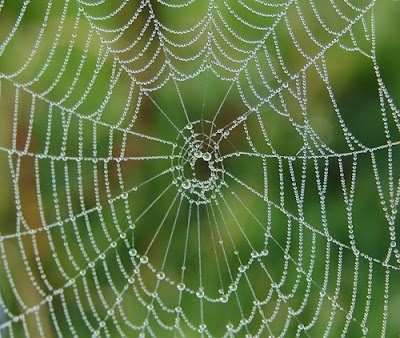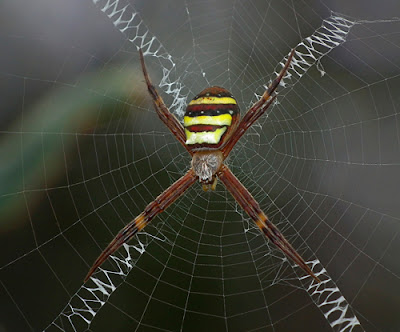A spider’s web has always attracted the attention of photographers. It is fascinating to observe and record the intricate designs and patterns that make up the web and how swiftly the spider moves when a prey touches the net. The spider is alerted of what is happening on the net via the vibrations that are caught by special receptors located in its feet. It is also an interesting fact that the fine silk that the spiders spin has a much greater tensile strength than that of steel of same weight. The spiders silk also has the advantage of being elastic in nature. Here are few tips that will help you get great photos of these magnificent creatures and the webs they make.
 |
| Photo By Robert S Donovan |
Best time to shoot
The best time to shoot a spider’s web is early mornings when you have the advantage of the sun’s golden rays falling at an angle lighting up the web. And during early mornings there are chances that the web is covered in dew. The weight of the dew drops sags the web a little making an interesting effect. Another great thing about early mornings is that there won’t be much wind. Since the spider web is very light even the slightest hint of a breeze could make it sway making it hard to photograph.
Choosing the Right Equipment
A DSLR with a dedicated macro lens should be your preferred gear. If you don’t have these then you could also make use of your point and shoot cameras. Make sure the macro mode of the camera is turned on.
Choosing the Right Background
A spider’s web always looks great when shot with a dark background. Dark green shades produced by the foliage tend to work best. Remember if the web is located at an easily accessible location and height. You could always add a background since the web is a relatively small thing.
 |
| Photo By Hungry Browser |
Depth of Field
A spider’s web looks better when it stands out of the background. So shoot with a large aperture to produce a very shallow depth of field. Since you are using a shallow depth of field the background will be blurred out of focus producing a smooth uncluttered feel. Take care to align all elements in your frame (the spider, web) in a single plain that is in focus, else you will end up with not so great results. Use your camera’s Depth of Field preview feature if it has one to determine exactly how much of the frame is in focus.
 |
| Photo By Jenny Downing |
Use Manual Focus Mode
Change your lens mode to manual focus mode and focus precisely. Since the web is a very fine thing even being slightly off focus could render your shot worthless.
 |
| Photo By Bob008 |
Composition Tips to Photograph a Spider's Web
Fill Your Frame
Fill your frame with the most interesting part of the subject. it could be the spider resting / feeding or the centre part of the web, or an insect struggling to break free from the web etc.
 |
| Photo By Bareego |
Follow the Rule of Thirds
Obey the Rule of Thirds and place your main focal point slightly off centre to make an interesting composition.
 |
| Photo By Pdam 2 |
Try composing from Both Sides of the Web
Each side of the spider’s web is different and you also get different backgrounds and lighting when you shoot from each side. So experiment with different compositions from both sides of the web.
 |
| Photo By Skender |
Whether to use a Tripod or not?
For photographing a spider’s web a tripod is not a must. Since the subject is stationary if you have steady hands then not using a tripod could prove very convenient for composing and framing. If you are worried about blur due to camera shake you could change your camera to continuous shooting mode and shoot multiple frames. If you are using a tripod make sure you turn of the Image Stabilization feature in your lens.
Whether to use Flash or not?
Natural light is great but in my personal experience I find that using a flash especially an off camera flash could greatly enhance the quality of the shot. It helps to brighten up the subject a shade more than the lighting for the background, making it stand out. It also brings out the details and produces pleasing highlights. You can use the sun’s rays to back-light the web and use your flash as the main light or vice versa to produce stunning results; especially so if the spider’s web is covered in dew.
Manipulating the Elements
If you are concerned about disturbing the natural balance and all ignore the following paragraph. Else try the techniques.
- Artificially create the dew on the web by using a mist sprayer.
- Feed the spider with some bugs or insects.
- Gently tap the surface that the web is attached on to make the spider change position.
 |
| Photo By Olibac |
Be very careful while experimenting with the aforesaid manipulation tips else you will end up ruining either the web or the shot or both
In the next article we will discuss about Photography - Nature and Wildlife Photography - How to Photograph Waterfalls
In the next article we will discuss about Photography - Nature and Wildlife Photography - How to Photograph Waterfalls
Post a Comment